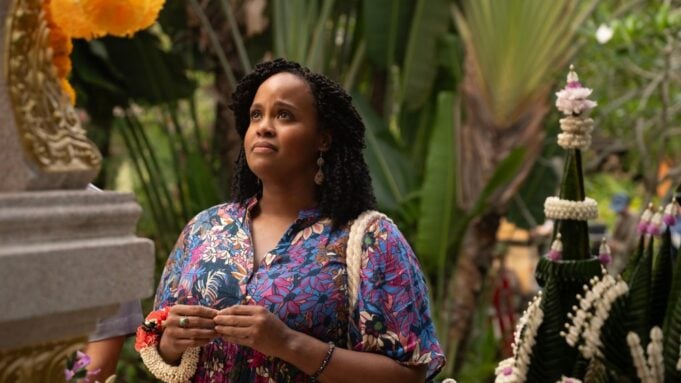Every season of “The White Lotus” marks a leveling up in ambition. The first, Maui-set season of the HBO anthology was a COVID-era contingency plan, shaped by the need for speed and physical isolation. After its creative and commercial success elevated auteur Mike White into the pantheon of prestige showrunners, Season 2 ventured further afield, both geographically (to Sicily) and away from its home base, with excursions across the Italian isle.
The third edition of the upstairs-downstairs dramedy, named for a fictional chain of upscale resorts, both continues this trajectory and complicates it. Shot largely on location at the Four Seasons in Koh Samui, an island off the southern coast of Thailand, Season 3 of “The White Lotus” may boast the most spectacular location yet, augmented by off-property adventures in Bangkok, at dance clubs and on palatial yachts — the kind of expensive, extra-crowded environments that were a distant dream back in the Hawai’i days. (Every season so far has featured a boat of escalating size, a visual metaphor for the series’ widening scope.) At eight episodes to its predecessors’ six and seven, respectively, Season 3 is also quite literally the biggest yet.
But, as White has telegraphed in interviews, the uniting theme is also the least conducive to the juicy schadenfreude that’s animated the previous installments. Season 1 was about class, culminating in the killing of general manager Armond (Murray Bartlett) by a boorish, entitled guest; Season 2 was about sex as power struggle, with wealthy-but-miserable heiress Tanya McQuoid (Jennifer Coolidge) falling victim to a murder plot by her gold-digging husband. Season 3, by contrast, is about spirituality. Per now-routine procedure, the cold open teases an unidentified dead body before flashing back by a week — a mystery milked more aggressively than ever before, with White deploying an actual Chekhov’s gun to loom over the action. This time, though, a guest prays for a loved one’s safety to an on-property statue of the Buddha. “The White Lotus” wants to explore what drives its materialist clientele to higher aspirations, like finding freedom from desire or locating the roots of one’s suffering. It’s an introspective turn from a series that is itself defined by an increasing abundance of resources.
White is simply too gifted a dramatist, and too acute an observer of human foibles, for these concerns to feel forced. They do, however, take a long time to set up, especially as the ensemble expands in size. Season 3 is the least immediately gripping entry in this running vacation diary to date; White seems to understand he’s earned our patience, and with a fourth season already guaranteed, there’s no need to continually justify the concept. But when the story coalesces and kicks into gear somewhere around its halfway point, it’s as wild and unpredictable as any of the powder kegs White has combusted.
Like any five-star experience, “The White Lotus” is oriented around the guests above all else. This batch comes in three clusters: an affluent Southern couple (Jason Isaacs and Parker Posey) indulging their daughter’s (Sarah Catherine Hook) interest in the meditation center down the beach, with her brothers (Patrick Schwarzenegger and Sam Nivola) along for the ride; a trio of lifelong girlfriends (Michelle Monaghan, Carrie Coon and Leslie Bibb) on a reunion trip; and a skeezy sad-sack (Walton Goggins) constantly lashing out at his much younger, more upbeat girlfriend (Aimee Lou Wood, of “Sex Education”). Naturally, each group’s facade hides a festering wound, from brewing scandal to simmering resentment to formative trauma.
The staff is more international and, thanks to the hotel’s vaunted wellness program, has a different orientation from past seasons. The general manager, Fabian (Christian Friedel, just as German but significantly less menacing than his character in “The Zone of Interest”), is a marginal character in the six episodes provided to critics. His clipped politesse is eclipsed by the glamorous Sritala (Lek Patravadi), a former actress turned health guru, and the hunky Valentin (Arnas Fedaravičius), a Russian “energy healer” assigned to the Bibb-Monaghan-Coon crew. Sweetest — and, given how this show tends to reward sincerity, most troubling — of all is the flirtation between gate attendant Gaitok (Tayme Thapthimthong) and his coworker Mook (Lalisa Manoban, of the K-pop girl group Blackpink), who nudges her affable, mild-mannered work friend to want more for himself.
Floating between these two groups is Belinda (Natasha Rothwell), the massage therapist last seen getting financially jilted by Tanya in Season 1. She’s on an internal exchange program to learn some tricks of the trade from Thai colleagues, but on a structural level, Belinda works to extend the master narrative that keeps “The White Lotus” from becoming a string of atomized excursions — or, in the eyes of the Emmy awards, a true anthology. Customers may come to the hotel for an escape, but just as Tanya’s happily ever after curdled into a nightmare, White keeps reminding viewers that actions have consequences, and people’s stories never simply end when they walk off the screen.
Love Film & TV?
Get your daily dose of everything happening in music, film and TV in Australia and abroad.
It takes time for these pieces to come together, or even for White to reveal all the pieces on the board. (Despite spending three paragraphs and counting on the cast, there are still more major characters and surprise cameos I’m forbidden from disclosing before air.) There’s a feeling of held breath to the first few episodes, which often end on anticlimactic downbeats, and a lack of calibration between performances. Posey, in particular, goes bigger than anyone else, appearing to aim for Coolidge-esque camp with a Southern drawl and slackened face — just wait until you hear how she says “lorazepam” — but ending up on a different frequency from her scene partners. Goggins goes strikingly depressive for an actor so often associated with grinning, gleeful jokesters, as in “The Righteous Gemstones.” It’s a sour, dyspeptic turn that’s bound to be polarizing, even if it leads directly to some of the season’s most thought-provoking questions.
While the audience waits for the bigger picture to coalesce, though, “The White Lotus” offers a delicious amuse bouche in the female trio: an aging actress (Monaghan), Texas housewife (Bibb) and freshly divorced attorney (Coon) whose frothy banter rapidly deteriorates into backbiting and old grievances. If their friction is vintage “White Lotus,” it’s bolstered by an interest in Thailand as a specific place with a specific relationship to Western tourism. One character derisively notes the presence of so-called “LBHs,” or “losers back home,” among the local population. “The White Lotus” will always adopt the vantage point of the dabbling visitor — after all, the production is only in town for a season at a time — but the more it’s able to wander off-trail, the more it’s able to push past the glossy surface. An episode tracing an increasingly unruly night on the town is a highlight.
Both previous seasons of “The White Lotus” were cemented by their endings. Who dies, how and by whose hand is the clearest means White has of communicating what he’s up to, whether it’s skewering a system where the rich quite literally suck the life out of the help or highlighting how love is just another hustle in a transactional world. It’s hard to evaluate Season 3 without such retroactive clarity. But these protagonists are all searchers, on the hunt for something that’s missing — deeper meaning, inner peace — in their everyday lives. It’s fitting their story privileges a wandering journey over a clear destination.
Season 3 of “The White Lotus” will premiere on HBO and Max on Feb. 16 at 9 p.m. ET, with remaining episodes airing weekly on Sundays.
From Variety US































